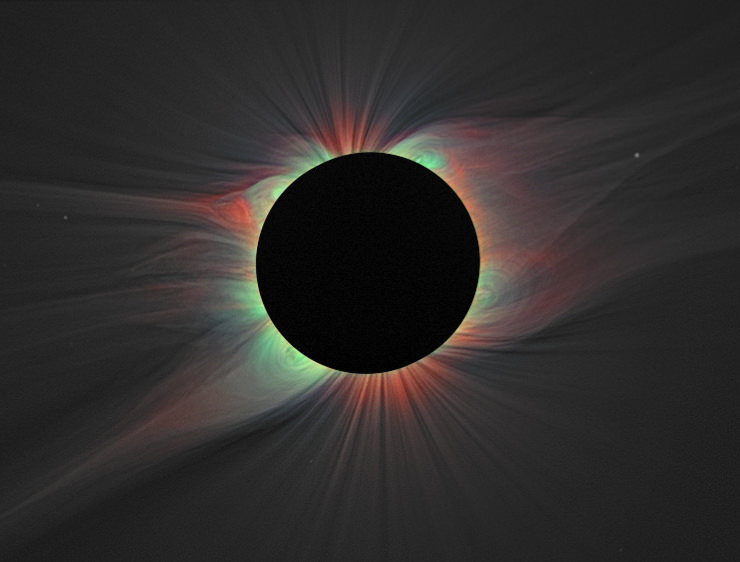This image of the solar corona contains a color overlay of the emission from highly ionized iron lines and white light taken of the 2008 eclipse. Red indicates iron line Fe XI 789.2 nm, blue represents iron line Fe XIII 1074.7 nm, and green shows iron line Fe XIV 530.3 nm. This is the first such map of the 2-D distribution of coronal electron temperature and ion charge state. Credit: Habbal, et al.
Astronomers presenting at this week’s AAS conference have reported on new research measuring the temperature of the solar corona. The work combines observations of the Sun’s outer reaches from observations during total solar eclipses in 2006, 2008, and 2009. It utilized mapping of various abundances of ionized iron to build a two dimensional temperature map.
Although many introductory science classes paint temperature as a fixed number, in reality, it’s the average of a range of temperatures which is a way of quantifying the kinetic energy of the particles in question. Individual particles may be hotter (higher kinetic energy) while others may be cooler (lower kinetic energy). As these atoms move around, they can collide and these collisions will knock off electrons causing the atoms to become ionized. The degree of ionization will be indicative of just how energetic the collision was.
Those ionized atoms can then be identified spectroscopically or by using a filter to search for the wavelength at which those atoms will emit light as new electrons settle down into the previously vacated orbitals. By measuring the relative amounts of ionization astronomers can then reconstruct the range of kinetic energies in the gas and thus, temperature range which can, in turn, be used to determine the average temperature.
This is the method an international team of astronomers used to study the sun’s corona. Since light atoms don’t work well for this method (they become fully ionized or just can’t show a large range of ionization like atoms with more electrons), the astronomers chose to study the Sun’s corona through various states of iron ionization. In doing so they mapped several ionization states, including capturing for the first time, the elusive Fe IX lines (iron with 8 electrons knocked off) at 789.2 nm.
One interesting finding was that the region of emission extended to three solar radii (or 1.5 times the diameter). After this distance, the collision rate drops off and can no longer cause the ionization of atoms (however, radiative processes caused by photons from the sun can still ionize the atoms, but this is no longer indicative of the temperature of the atoms). This was further than originally anticipated.
Another result of their work showed that there is a strong correspondence between the amounts of various ions coming from the sun and that same ratio in interplanetary space as measured by the SWICS on the Advanced Composition Explorer. This connection will better help astronomers understand the working of our Sun as well as how its emissions may impact the Earth.
The full results of this work are to be published in the January 10 issue of the Astrophysical Journal.


At the second paragraph, in the second line:
That should be it’s (it is), not “its”.
Also, at the fourth paragraph, in the fourth line:
I think that you meant so, not “to”.
Err… I’ll get my coat and see myself out…
I don’t know how to put this without being rude, but IVAN3MAN is seriously tempting me to only browse through feeds. I noted this commented article but finds that it’s about trivial spelling errors that doesn’t affect readability much.
This on blogs is like entering another’s apartment and start criticizing the dents in the furniture. Everyone is embarrassed, and it takes time and energy from talking of essential things like, um, the weather. 😀
[Actually it is more like spitting on the floor, rubbing it in, and noting with high voice how clean and polished the result looks compared to the dirt layer. :-/]
… and I know it’s manic behavior, but seriously, it hurt others. Not much perhaps, but it’s like that whining bug that you somehow never can swat. Please refrain.
MAAANO MAN! THAT is one beautiful image! and a sure magnet for debate~
I’m trying to imagine just how Sol creates ionized iron through fusion processes? Does it indeed have an iron heart? Maybe I better ask Dr. Oliver K. Manual? http://www.omatumr.com/resume.html
Aqua:
LOL 🙂 Dr. Manual’s personal cosmology is a never ending source of amusement over at PhysOrg (where I post as yyz). Can’t for the life of me envision the Sun as a supernova remnant powered by neutron repulsion.
Those delicate, extended polar brushes are a sight to behold.
Story sez “the elusive Fe IX lines (iron with 9 electrons knocked off)” . Shouln’t Fe IX be missing 8 electrons? I thought FeI was ground state, Fe II was missing 1 electron, Fe III was missing 2 electrons and so on. Did I get this wrong?
Typos fixed. Thanks for catching those everyone.
Hey Jon,
Maybe you could use a proof reader or 2 over at UT. Seems these guys have a lot of idle time on their hands. Could be they are looking for work.
I said “or 2” as there’s another poster that nit picks a lot. Can’t think of the name right off hand.
This picture is so beautiful. Once again I am in awe of such astronomical beauty ‘out there’. I want to paint this picture…..smiles!!
Interesting short article depicting variations of ionized iron from the suns heat/light energy.
Good job and thanks for posting it.
in peace,
Optimum